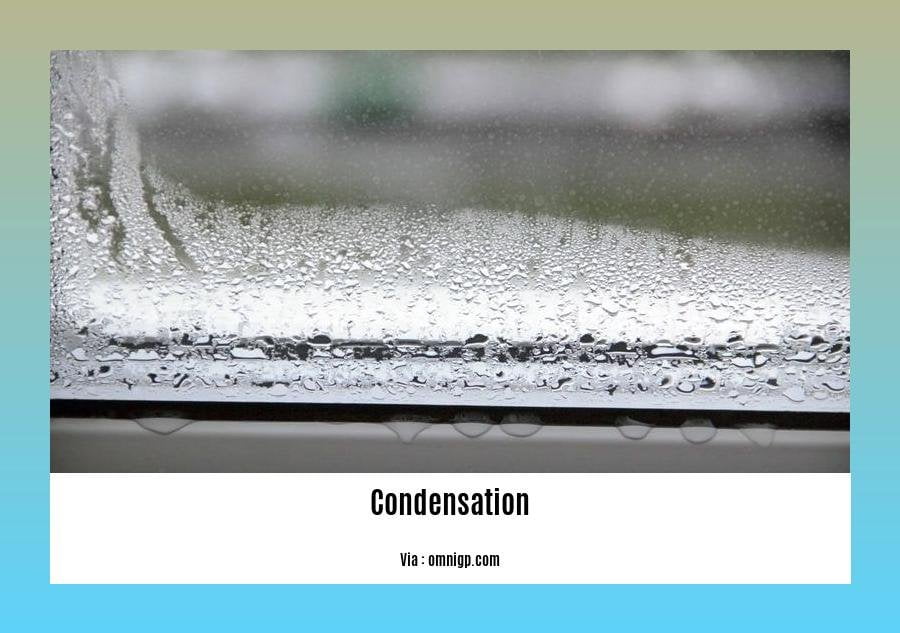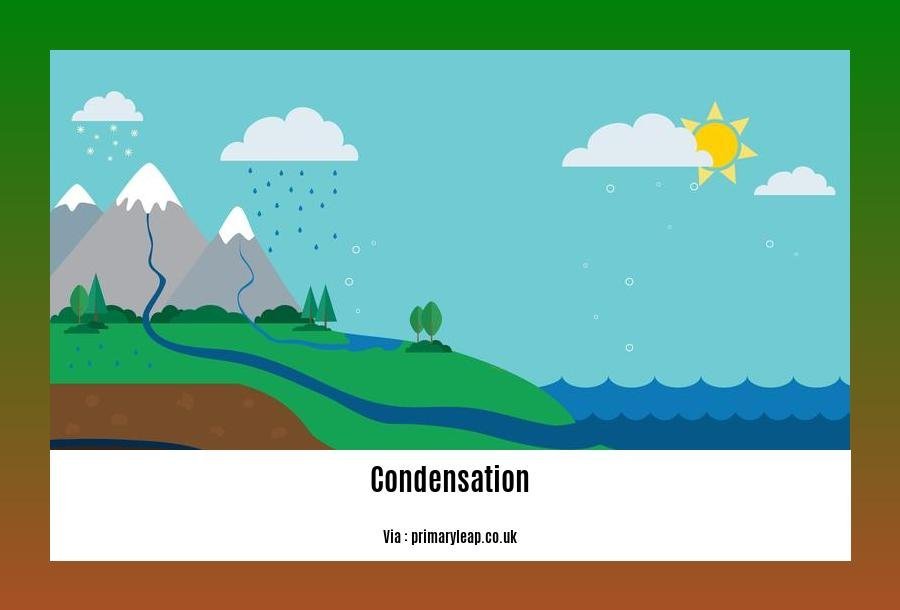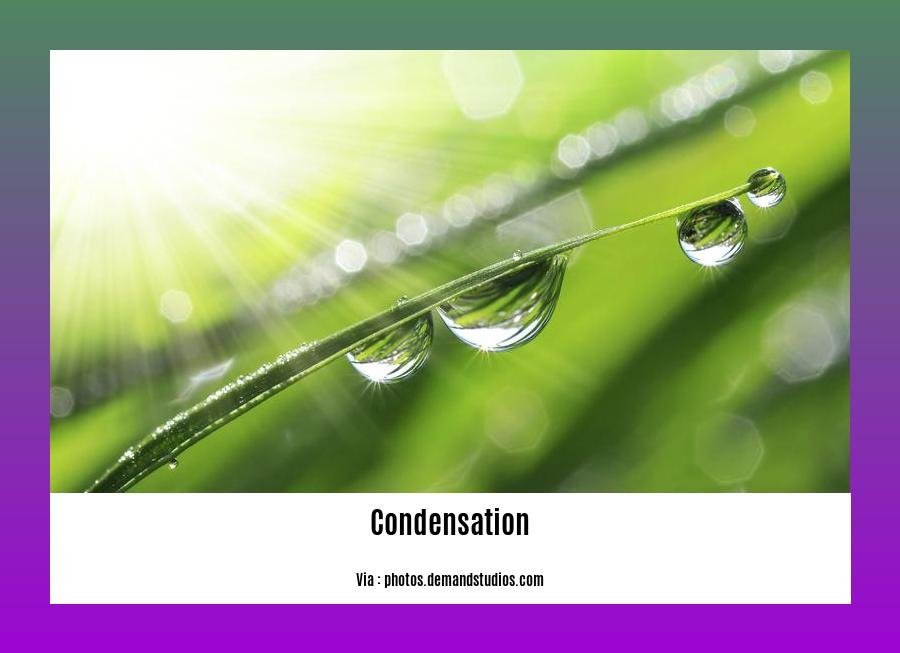Unveiling the Marvels: Fascinating Facts About Condensation in the Water Cycle unveils the captivating world of condensation and its extraordinary significance in the water cycle. This article delves into the realm of scientific knowledge, exploring the essential role of temperature, humidity, and atmospheric dynamics in the mesmerizing phenomenon of condensation. Through concise and accessible content, readers will gain a comprehensive understanding of the intricate workings of condensation and its influence on our planet’s sustenance and balance.
Key Takeaways:
- Condensation is the process in the water cycle where water vapor in the air changes into liquid water.
- Condensation is responsible for the formation of clouds and other weather phenomena.
- It plays a crucial role in maintaining the balance of water on Earth and regulating the climate.
- Condensation helps in redistributing water resources and provides a source of freshwater for plants, animals, and humans.
- Evaporation is the conversion of liquid water to water vapor, while condensation is the opposite process.
- Both condensation and precipitation are important components of the water cycle, replenishing water sources on Earth.
Facts About Condensation in the Water Cycle

Process of Condensation
- Condensation occurs when water vapor cools down and reaches its dew point, changing from a gas to a liquid state.
- It can happen through the production of atomic clusters within a gaseous volume or through the interaction of a gaseous phase with a liquid or solid surface.
Formation of Clouds
- Condensation is responsible for the formation of clouds.
- As water vapor rises into the atmosphere and cools, it forms tiny water droplets that gather together to create visible clouds.
- These clouds can then produce precipitation such as rain or snow.
Crucial to the Water Cycle
- Condensation, along with evaporation, precipitation, and other processes, plays a key role in maintaining the balance of water on Earth.
- It helps in redistributing water resources and regulating the climate.
Importance of Condensation
- Condensation has numerous impacts on the environment and living organisms.
- It contributes to the formation of rain and provides a source of freshwater for plants, animals, and human beings.
- Additionally, condensation helps purify water by removing impurities through the precipitation process.
Difference between Evaporation and Condensation
- Evaporation involves the conversion of liquid water to water vapor, while condensation is the opposite process.
- Evaporation occurs when heat is added, while condensation occurs when heat is removed.
Role in the Water Cycle
- Both condensation and precipitation are important components of the water cycle.
- Water is transferred from the surface to the atmosphere through evaporation, which then condenses to form clouds.
- These clouds release precipitation in the form of rain, snow, or hail, replenishing water sources on Earth.
Understanding the process of condensation helps us appreciate its importance and impact on our planet’s climate and ecosystem.
Sources
– U.S. Geological Survey – Condensation and the Water Cycle
– Kidadl – Condensation Facts: Environmental Science
Here are two active internal links for you:
Facts about Condensation: Discover fascinating information about condensation, from how it forms to its effects on our daily lives.
Facts about the Desert Southwest Region: Dive into the wonders of the desert Southwest region and learn about its unique geography, climate, and cultural heritage.
Factors That Influence Condensation in the Atmosphere
Condensation, a fascinating process within the water cycle, is influenced by various factors that shape its occurrence in the atmosphere. Understanding these factors can help shed light on the marvels of condensation and its significance in maintaining Earth’s balance. In this article, we will explore the key factors that influence condensation and unravel the secrets behind this captivating phenomenon.
The Role of Temperature and Humidity
Temperature plays a crucial role in condensation as it determines the dew point, the temperature at which condensation occurs. When air is cooled to its dew point or becomes saturated with water vapor, it can no longer hold the moisture, leading to the formation of water droplets. Additionally, low temperatures contribute to condensation when humid air encounters cold surfaces, triggering the transformation of water vapor into liquid water.
Humidity, the amount of water vapor in the air, also influences condensation. When the air is saturated with moisture, it reaches its maximum capacity to hold water vapor. High humidity increases the likelihood of condensation, especially in environments characterized by low temperatures.
Atmospheric Dynamics
The dynamics of the atmosphere influence condensation by shaping the movement of air masses and the distribution of moisture. Air circulation patterns, such as convection currents, affect the transport of moist air, facilitating the formation of clouds and the subsequent condensation process. These atmospheric dynamics create the ideal conditions for water vapor to transform into liquid water, giving rise to the majestic clouds we observe in the sky.
Ventilation and Air Circulation
Ventilation plays a significant role in condensation. Poor ventilation traps hot and humid air indoors, inhibiting its escape and causing moisture to accumulate. This buildup creates a favorable environment for condensation to occur. Proper ventilation, on the other hand, allows for the exchange of indoor and outdoor air, preventing excessive humidity levels and reducing the chances of condensation.
The Water Cycle and Climate
Condensation is an integral part of the water cycle, a vital process that sustains life on Earth. The water cycle encompasses evaporation, transpiration, condensation, precipitation, and the runoff of water. Evaporation and transpiration, driven by the sun’s energy, lead to the formation of water vapor, which later undergoes condensation to form clouds. These clouds, in turn, give rise to precipitation, providing freshwater for plants, animals, and humans. The balance between evaporation, condensation, and precipitation regulates the Earth’s climate and influences weather patterns worldwide.
Key Takeaways:
- Temperature and humidity are key factors influencing condensation in the atmosphere.
- Low temperatures contribute to condensation, as cold surfaces cause water vapor to transform into liquid water.
- Humidity, or the amount of water vapor in the air, affects condensation.
- Atmospheric dynamics, such as convection currents, play a role in condensation by transporting moist air and facilitating cloud formation.
- Ventilation and air circulation impact condensation, with poor ventilation leading to an accumulation of humidity indoors.
- Condensation is an essential process within the water cycle, regulating the climate and providing freshwater for ecosystems.
Suggested sources for further reading:
– National Geographic Society
– Khan Academy
Examples of Condensation in the Natural Environment

Condensation, the magical process where water vapor transforms into liquid water, can be observed in various forms throughout the natural environment. From everyday occurrences to stunning natural phenomena, examples of condensation abound, showcasing the wonders of the water cycle. Let’s delve into the intriguing examples of condensation that grace our world!
Dewdrops Glistening on the Grass
Imagine waking up on a crisp morning, stepping outside, and being greeted by delicate dewdrops adorning the blades of grass. This ethereal sight is a beautiful demonstration of condensation in action. During the night, as the Earth’s surface loses heat, it cools the surrounding air. When the temperature drops below the dew point, water vapor in the air condenses, forming tiny droplets on surfaces like grass, leaves, and flowers. These glistening dewdrops serve as a gentle reminder of nature’s harmonious cycle, providing vital moisture to sustain life.
Misty Mornings and Enchanting Fog
Step into a scene straight out of a fairy tale, where rolling mist encircles trees and shrouds the landscape in an otherworldly cloak. Mist and fog, both captivating examples of condensation, occur when warm, moisture-laden air comes into contact with cooler surfaces or encounters colder air masses. As the air cools, it loses its ability to retain the abundant water vapor, resulting in the formation of tiny liquid droplets suspended in the atmosphere. Mist and fog not only add a touch of mystery to our surroundings but also have practical implications, such as aiding moisture-loving plants and providing valuable water resources.
Clouds: Nature’s Celestial Art
When we gaze up at the sky and witness the astonishing display of clouds, we are witnessing condensation on a grand scale. Clouds are formed when warm air rises, carrying with it invisible water vapor. As this warm air ascends to higher altitudes, it encounters cooler temperatures, causing the water vapor to condense into visible water droplets or ice crystals. The result? Majestic cloud formations that not only captivate our imaginations but also contribute to weather patterns, shade the Earth’s surface, and even reflect sunlight, influencing our planet’s temperature and climate.
Marvels of Moisture: Rain and Precipitation
As condensation culminates in its most dramatic form, we witness one of nature’s greatest spectacles—rain. Rainfall occurs when cloud droplets grow larger, merging together to form heavy droplets that fall under gravity’s pull. This mesmerizing process replenishes our lakes, rivers, and oceans, nourishes plants and crops, and sustains life as we know it. From gentle drizzles to torrential downpours, rain reminds us of the powerful interconnectedness between condensation, precipitation, and the ever-flowing water cycle.
Closing Thoughts
The examples of condensation in the natural environment are not only awe-inspiring but also crucial for the equilibrium and sustenance of our planet. From the delicate dewdrops on grass to the expansive canvas of clouds, condensation weaves its magic, showcasing the elegance and complexity of the water cycle. So, the next time you witness condensation in action, take a moment to appreciate the remarkable interplay of temperature, humidity, and atmospheric dynamics that shape our world.
Key Takeaways:
- Condensation manifests itself in various forms, including dewdrops on grass, misty mornings, clouds, and rainfall.
- Dewdrops form when the temperature drops below the dew point, causing water vapor to condense on surfaces.
- Mist and fog occur when warm, moist air encounters cooler surfaces or air masses, leading to condensation of water vapor in the air.
- The mesmerizing formations of clouds are a result of condensation as warm air rises, cools, and water vapor transforms into droplets or ice crystals.
- Rainfall is the dramatic culmination of condensation, with cloud droplets merging and falling as precipitation.
- These examples of condensation highlight the vital role it plays in the water cycle, sustaining life and influencing climate patterns.
Sources:
- Candler, Laura. “Investigating Condensation and the Water Cycle.” lauracandler.com. Source
- White, Mary Gormandy. “10 Condensation Examples Common in Real Life.” YourDictionary. Source
The Importance of Condensation for Ecosystems and the Planet
Condensation, a remarkable process in the water cycle, plays a vital role in our planet’s ecosystems and overall sustenance. Through the transformation of water vapor into liquid water, condensation ensures the balance and availability of freshwater, while providing numerous benefits to plants, animals, and the environment.
Key Takeaways:
– Condensation is the process of water vapor turning into liquid water.
– It is a crucial component of the water cycle, facilitating the movement of water on, above, and below the Earth’s surface.
– The importance of condensation for ecosystems and the planet cannot be overstated, as it supports various essential functions.
Water Distribution and Access
Condensation enables the distribution of water on a wider scale, ensuring its availability for plants and animals. Through the formation of clouds and the subsequent growth of cloud droplets, condensation facilitates the production of precipitation. This precipitation, in the form of rain, snow, or hail, helps transport water from the atmosphere back to the Earth’s surface. It allows water to be spread out more widely, reaching areas where it may be scarce or inaccessible.
Agricultural Support and Food Security
Farmers heavily rely on condensation for watering their crops, which reduces their dependence on irrigation. By harnessing the moisture provided through condensation, agricultural practices can mitigate the impact of droughts and dry spells. Adequate condensation ultimately contributes to healthier and more abundant crop growth, helping to ensure food security and prevent potential food shortages during very dry seasons.
Climate Regulation
Condensation plays a significant role in regulating climate by facilitating energy exchanges within the atmosphere. As water vapor condenses into liquid water, it releases energy, warming the surrounding environment. This process helps maintain the overall balance of energy within the Earth’s system. By understanding the intricate dynamics of condensation and the water cycle, we can appreciate its influence on climate patterns and predict potential climate difficulties.
Environmental Balance
Condensation contributes to the overall balance of ecosystems, as it acts as a natural purifier of water. Water vapor rising into the atmosphere carries impurities, and as it condenses, these impurities are removed through the precipitation process. This purification ensures that freshwater sources, such as lakes, rivers, and groundwater, remain free from excessive contaminants, benefiting both the environment and the organisms that rely on these water sources.
Sources:
- Candler, Laura. “Investigating Condensation and the Water Cycle.” lauracandler.com. Source
- White, Mary Gormandy. “10 Condensation Examples Common in Real Life.” YourDictionary. Source
FAQ
Q1: How does condensation occur in the water cycle?
A1: Condensation occurs when water vapor cools down and reaches its dew point, changing from a gas to a liquid state. This process is crucial in the formation of clouds and other weather phenomena.
Q2: What is the role of condensation in the water cycle?
A2: Condensation plays a vital role in the water cycle by converting water vapor into liquid water. It helps in the formation of clouds and the production of precipitation, which redistributes water resources and maintains the balance of water on Earth.
Q3: What are some examples of condensation in everyday life?
A3: Examples of condensation in everyday life include water droplets forming on a cold glass, fog appearing on a bathroom mirror after a hot shower, and dew collecting on grass or spider webs in the morning.
Q4: How does condensation benefit the environment and living organisms?
A4: Condensation is essential for the environment and living organisms as it contributes to the formation of rain, which provides a source of freshwater for plants, animals, and humans. It also helps in the purification of water by removing impurities through the precipitation process.
Q5: How is condensation different from evaporation?
A5: While evaporation involves the conversion of liquid water to water vapor, condensation is the opposite process where water vapor changes back into liquid water. Evaporation typically occurs when heat is added, while condensation occurs when heat is removed.
- Understand bone yellow: Colorism’s impact on Black communities - April 19, 2025
- Green Natural Sandstone: Eco-Friendly Building Solutions - April 19, 2025
- Red Cross Flag: Protecting Humanity Through History - April 19, 2025
















